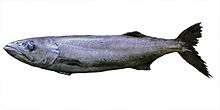Oilfish
The oilfish (Ruvettus pretiosus) is a species of snake mackerel with a cosmopolitan distribution in tropical and temperate oceans. It can be found at depths of from 100 to 800 metres (330 to 2,620 ft), usually between 200 to 400 metres (660 to 1,310 ft). It can grow to a length of 300 centimetres (120 in) TL (nearly 10 feet) though most do not exceed 150 centimetres (59 in) SL. The maximum recorded weight is 63.5 kilograms (140 lb). It is currently the only known member of its genus.[2]
| Oilfish | |
|---|---|
 | |
 | |
| Scientific classification | |
| Kingdom: | Animalia |
| Phylum: | Chordata |
| Class: | Actinopterygii |
| Order: | Scombriformes |
| Family: | Gempylidae |
| Genus: | Ruvettus Cocco, 1833 |
| Species: | R. pretiosus |
| Binomial name | |
| Ruvettus pretiosus Cocco, 1833 | |
| Synonyms | |
| |
The flesh of this fish is extremely oily and although edible, the oil actually consists of wax esters, which are not digested like edible oils. The flesh has an oil content of around 25%, and with serving sizes of several ounces and upwards commonplace, some people experience a laxative side effect from such a large amount of wax esters. Some consumers of large amounts oilfish also experience abdominal cramps and vomiting.
Oilfish is pleasantly rich in taste and can be substantially cheaper than some other fish species, leading to some fish sellers intentionally mislabelling it as butterfish or even codfish, despite the utter lack of relation. This leads the consumer to often eat larger servings, as they assume it is a fish with which they are familiar, and then may experience a laxative effect. Because of this, Japan and Italy have imposed an import ban on oilfish. Australia does not ban oilfish from being sold but recommends retailers and caterers to inform consumers about the potential risk associated with oilfish consumption.[3] The US FDA has warned consumers about potential mislabeling of oilfish and any laxative or vomiting side effects that occur are at worst uncomfortable, but pose no health risk.[4] Escolar, a relative of oilfish, also has high concentrations of wax esters and is often similarly mislabeled.
Hong Kong oilfish controversy
Hong Kong's ParknShop supermarket was selling oilfish as "cod fish (oilfish)" in its stores. Consumers ate the fish, believing it to be codfish, then suffered oily diarrhea (keriorrhea) as a result. The oilfish-labelling controversy was reported by a number of news and media organizations, such as TVB Newsmagazine. A total of 14 complaints were filed against the supermarket chain, leading to an investigation by the Centre for Food Safety. ParknShop has denied responsibility, claiming the fish is safe for human consumption. Nonetheless, the chain has since stopped selling the fish product.[5][6]
On 30 January 2007, the commercial attache from the Indonesian consulate in Hong Kong confirmed the export health certificate Mr Peter Johnston, ParknShop's Quality Food Safety and Regulatory Affairs General Manager, had used in its media conference several days earlier, was doctored. The attache explained its fisheries department, under a request from the Hong Kong importer, had changed the product name, by including "Cod Fish" alongside its scientific name, on the certificate.
As a result of the ParknShop-oilfish incident, Centre for Food Safety in Hong Kong published new guidelines on the proper labelling of oilfish to consumers, such that oilfish species Ruvettus pretiosus and Lepidocybium flavobrunneum should not be labelled as "cod".[7][8] ParknShop was also fined HKD 45,000 after pleading guilty to 9 counts of misrepresentation of products.[9]
The Canadian Broadcasting Corporation reported in 2007 on several cases in Canada where mislabelled oilfish was sold at Chinese supermarkets.[10][11][12][13][14]
See also
References
- Collette, B.B.; Curtis, M.; Smith-Vaniz, W.F.; et al. (2015). "Ruvettus pretiosus". The IUCN Red List of Threatened Species. 2015: e.T190432A16644022. doi:10.2305/IUCN.UK.2015-4.RLTS.T190432A16644022.en.
- Froese, Rainer and Pauly, Daniel, eds. (2013). "Ruvettus pretiosus" in FishBase. April 2013 version.
- "Escolar and oilfish health warning" (PDF). Queensland Health. October 2011. Archived from the original (PDF) on March 29, 2012.
- "Annex 2 - Seafood References for Managing Food Safety: A Manual for the Voluntary Use of HACCP Principles for Operators of Food Service and Retail Establishments". U.S. Food and Drug Administration. December 5, 2011 [First published April 2006]. Archived from the original on November 23, 2012.
- Froese, Rainer and Pauly, Daniel, eds. (2006). "Ruvettus pretiosus" in FishBase. February 2006 version.
- Ayling, Tony; Cox, Geoffrey (1982). Collins Guide to the Sea Fishes of New Zealand. Auckland, New Zealand: William Collins Publishers Ltd. ISBN 978-0-00-216987-5.
- "Guidelines on identification and labelling of oilfish and cod issued". Hong Kong: Centre for Food Safety. August 16, 2007.
- "Guidelines on Identification and Labelling of Oilfish/Cod" (PDF). Hong Kong: Centre for Food Safety.
- Lau, Nickkita (December 18, 2007). "ParknShop hit with 'mild' $45,000 fine for mislabeling oilfish as cod". The Standard. Archived from the original on June 29, 2011.
- "Canadians fall ill after eating mislabelled oily fish". CBC News. February 23, 2007. Archived from the original on October 23, 2012.
- "ParknShop explains why oilfish was labelled as cod". rthk.hk. January 24, 2007. Archived from the original on September 10, 2007.
- Kim, Caroline (January 31, 2007). "All parties in oilfish saga to face probe". The Standard. Hong Kong. Archived from the original on March 29, 2008.
- "Probe over oilfish marketed as codfish". news.gov.hk. Hong Kong. January 23, 2007.
- "海洋行要求衛生證油魚改鱈魚 印尼出口商涉欺詐 或吊銷牌照". Ming Pao Daily News (in Chinese). Ming Pao New York. January 30, 2007. Archived from the original on September 29, 2007.
